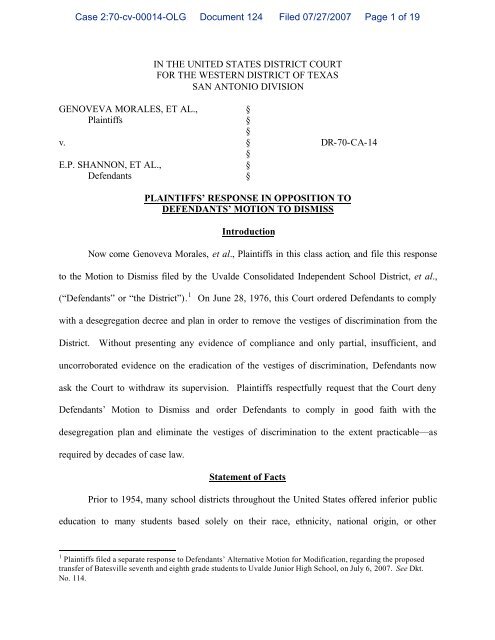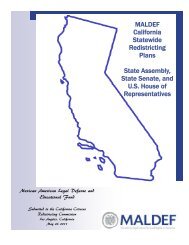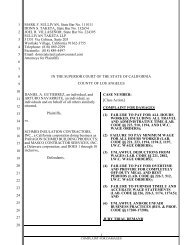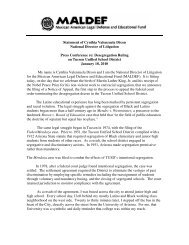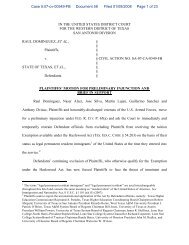Response to Defendants' Motion to Dismiss - maldef
Response to Defendants' Motion to Dismiss - maldef
Response to Defendants' Motion to Dismiss - maldef
Create successful ePaper yourself
Turn your PDF publications into a flip-book with our unique Google optimized e-Paper software.
Case 2:70-cv-00014-OLG Document 124 Filed 07/27/2007 Page 1 of 19IN THE UNITED STATES DISTRICT COURTFOR THE WESTERN DISTRICT OF TEXASSAN ANTONIO DIVISIONGENOVEVA MORALES, ET AL., §Plaintiffs §§v. § DR-70-CA-14§E.P. SHANNON, ET AL., §Defendants §PLAINTIFFS’ RESPONSE IN OPPOSITION TODEFENDANTS’ MOTION TO DISMISSIntroductionNow come Genoveva Morales, et al., Plaintiffs in this class action, and file this response<strong>to</strong> the <strong>Motion</strong> <strong>to</strong> <strong>Dismiss</strong> filed by the Uvalde Consolidated Independent School District, et al.,(“Defendants” or “the District”). 1On June 28, 1976, this Court ordered Defendants <strong>to</strong> complywith a desegregation decree and plan in order <strong>to</strong> remove the vestiges of discrimination from theDistrict. Without presenting any evidence of compliance and only partial, insufficient, anduncorroborated evidence on the eradication of the vestiges of discrimination, Defendants nowask the Court <strong>to</strong> withdraw its supervision. Plaintiffs respectfully request that the Court denyDefendants’ <strong>Motion</strong> <strong>to</strong> <strong>Dismiss</strong> and order Defendants <strong>to</strong> comply in good faith with thedesegregation plan and eliminate the vestiges of discrimination <strong>to</strong> the extent practicable—asrequired by decades of case law.Statement of FactsPrior <strong>to</strong> 1954, many school districts throughout the United States offered inferior publiceducation <strong>to</strong> many students based solely on their race, ethnicity, national origin, or other1 Plaintiffs filed a separate response <strong>to</strong> Defendants’ Alternative <strong>Motion</strong> for Modification, regarding the proposedtransfer of Batesville seventh and eighth grade students <strong>to</strong> Uvalde Junior High School, on July 6, 2007. See Dkt.No. 114.
Case 2:70-cv-00014-OLG Document 124 Filed 07/27/2007 Page 2 of 19protected status. See Brown v. Bd. of Educ., 347 U.S. 483 (1954). Uvalde CISD was one ofthose districts that discriminated against students by creating two separate elementary schools forMexican-American children, East Garden and West Garden. Morales v. Shannon, 516 F.2d 411(1975) cert. denied, 423 U.S. 1034 (1976). In 1954, the United States Supreme Court declaredthat racial segregation in public schools is unconstitutional. Id. In the face of widespread noncompliancewith its ruling in Brown v. Board, the Supreme Court ordered the school districts inthat litigation <strong>to</strong> desegregate “with all deliberate speed.” See Brown v. Bd. of Educ., 349 U.S.294, 301 (1955) (Brown II).In 1968, because many school districts continued <strong>to</strong> defy the mandate <strong>to</strong> desegregate theirschools, the Supreme Court stated “the time for mere ‘deliberate speed’ has run out,” anddeclared that recalcitrant districts must institute a plan that “promises realistically <strong>to</strong> work, andpromises realistically <strong>to</strong> work now.” Green v. Count School Bd. of New Kent County, 391 U.S.430, 437-38 (1968) (emphasis in original). Many school districts began the process <strong>to</strong>immediately desegregate their schools but others continued <strong>to</strong> defy the Supreme Court’s decisionand the United States Constitution. Defendant Uvalde CISD was among those districts thatcontinued <strong>to</strong> operate a separate and unequal school system based on a student’s race, ethnicity, ornational origin. See generally Morales, 516 F.2d 411. As a result of Defendants’ decision <strong>to</strong>continue <strong>to</strong> deny Latino students of their rights, Plaintiffs instituted this class action in 1970challenging the District’s failure <strong>to</strong> provide equal educational opportunities <strong>to</strong> Mexican-American schoolchildren and <strong>to</strong> English Language Learner students (“ELL students”). 2In 1975, the Fifth Circuit reversed, in part, a decision by the district court and foundstrong evidence of segrega<strong>to</strong>ry intent in Uvalde’s public school system against Mexican-2 English Language Learner students are also known and classified as students identified with limited-Englishproficiency (“LEP Students”) under state law. See TEX. EDUC. CODE §29.052. The terms are used interchangeablythroughout the brief.2
Case 2:70-cv-00014-OLG Document 124 Filed 07/27/2007 Page 3 of 19American schoolchildren. 3Id. at 413. The Fifth Circuit’s opinion was partially based on theneighborhood assignment of students <strong>to</strong> the Robb and Anthon elementary schools, which hadmerely replaced the two prior Mexican schools of East Garden and West Garden. Id. The FifthCircuit found that the neighborhood assignment system, coupled with the District’s “freedom ofchoice” plan, 4 merely perpetuated the intentional segregation of Latino students originally causedby the establishment of Mexican schools. Id.On June 28, 1976, this Court entered a desegregation decree. See Decree, Dkt. No. 59.The decree addressed many issues including: student assignments; principals, faculty, staff andaide assignments, hiring, and reductions; programs for English Language Learner students;classroom assignments; transportation; facilities; and annual reporting requirements. Id. TheCourt directed the implementation of the District’s proposed desegregation plan, and thebilingual-bicultural program for the ELL students, <strong>to</strong> assist in carrying out the mandates underthe decree. Id. As the Court professed, the implementation of the desegregation plan and thebilingual-bicultural education program “will suffice <strong>to</strong> convert the School District <strong>to</strong> a unitaryschool district.” Id.In 1995, Defendants filed their first <strong>Motion</strong> for Modification of the Decree in which theysought Court approval not only <strong>to</strong> modify the student assignment plan in the elementary schools,but also <strong>to</strong> incorporate a plan addressing quality of education issues for minority children in theDistrict. Defendants recognized the need <strong>to</strong> address quality of education issues in thedesegregation plan, due in part <strong>to</strong> the poor academic performance of its minority students. SeeDefs.’ First Mot. for Modification, UCISD Proposed Elementary Grade Arrangement for 1995-3 Plaintiffs refer <strong>to</strong> Mexican-American students as Latino students in this brief. The State of Texas refers <strong>to</strong> Latinostudents as Hispanic students.4 As the Court pointed out, the freedom of choice plan resulted in 154 Anglo students selecting the predominantlyAnglo school, Dal<strong>to</strong>n Elementary. Id.3
Case 2:70-cv-00014-OLG Document 124 Filed 07/27/2007 Page 4 of 1996, Ex. 8 at 1; App.- Ex. P-1 (“1995 Plan”). The parties agreed <strong>to</strong> incorporate the gradearrangement plan in<strong>to</strong> the desegregation plan, and also agreed <strong>to</strong> include additional reportingrequirements for the District. See id. at Ex. 7, Supplement <strong>to</strong> Desegregation Order in Morales v.Shannon; attached <strong>to</strong> App.- Ex. P-2. The Court granted that motion and modified the planaccordingly. See Order dated May 5, 1995.In July 2002, the District filed its Second <strong>Motion</strong> for Modification of the Decree. 5In themotion, the District requested the implementation of a School District of Choice Program.Among other obligations under the Choice Program, the District would develop a specialcurricula program at the Batesville School and allow students from Uvalde <strong>to</strong> attend theBatesville School and students from Batesville <strong>to</strong> attend the Uvalde schools. See Dkt. No. 97.The motion was granted and the Court subsequently amended the plan a second time.On June 5, 2007, Plaintiffs sent <strong>to</strong> Defendants a letter inquiring about the District’sdecision <strong>to</strong> transfer all seventh and eighth grade students from the Batesville School <strong>to</strong> UvaldeJunior High, and whether the District intended <strong>to</strong> seek court approval for the transfer. See Letter<strong>to</strong> District, App.- Ex. P-3. Plaintiffs also requested that the District forward copies of theDistrict’s Annual Report for the last 3 years. The District responded by stating that theBatesville transfer issue did not require court approval. See Letter from Cook, June 15, 2007;App.- Ex. P-4. After a second request by Plaintiffs for documents related <strong>to</strong> the Batesvilletransfer and for a complete Annual Report, Plaintiffs instead received the pending motion <strong>to</strong>dismiss from Defendants without any notice from the District. 6Defendants now ask fordismissal from the court’s jurisdiction al<strong>to</strong>gether, based primarily on the mere passage of time5 Plaintiffs’ argument related <strong>to</strong> the Batesville School transfer issue is addressed in their response <strong>to</strong> the District’ssecond motion <strong>to</strong> modify and is fully incorporated herein. See Dkt. No. 114.6 Plaintiffs also received from Defendants an amended annual report from the District, but as explained below, this<strong>to</strong>o did not meet the Court’s Order.4
Case 2:70-cv-00014-OLG Document 124 Filed 07/27/2007 Page 5 of 19and the changing demographics. 7However, as explained below, such overly broad, unsupportedassertions do not satisfy their burden <strong>to</strong> support dismissal of the Court’s order.ArgumentThe goal of a school desegregation plan has been defined as the transition from a dualsystem <strong>to</strong> a unitary, nonracial system of public education. Green, 391 U.S. at 436. In order for acourt <strong>to</strong> determine whether it should discontinue judicial oversight, two central questions must beaddressed by the movant: 1) whether the defendant school district “ha[s] complied in good faithwith the desegregation decree since it was entered;” and 2) “whether the vestiges of pastdiscrimination ha[ve] been eliminated <strong>to</strong> the extent practicable." Frazar v. Ladd, 457 F.3d 432,439 (5th Cir. 2006) (citing Freeman v. Pitts, 503 U.S. 491-492 (1992)). Additionally,Defendants must demonstrate that retention of judicial control is unnecessary or impracticable <strong>to</strong>achieve compliance with the order in the various facets of the system and the district hasdemonstrated <strong>to</strong> the public and <strong>to</strong> the parents and the students of the once disfavored races agood faith commitment <strong>to</strong> the whole of the order and <strong>to</strong> those provisions of the law and theConstitution that laid the predicate for judicial intervention. Freeman, 503 U.S. at 491.Defendants’ motion should be denied because they fail <strong>to</strong> satisfy their burden of provinggood faith compliance with the desegregation plan and the elimination of the vestiges ofdiscrimination. Tellingly, Defendants provide virtually no evidence of compliance with theactual provisions of the desegregation plan. The vestiges of discrimination continue in theDistrict through racially disparate student assignments <strong>to</strong> schools and classrooms, racially7 Defendants also allege Plaintiffs have never complained of the District’s compliance over the last thirty years. SeeDefs.’ Mot. <strong>to</strong> <strong>Dismiss</strong> at 6 12. Although such “inaction” would be of no consequence in relieving Defendants oftheir burden in this case, complaints and official reports of the differing treatment of Latinos are well documented.See, e.g., Memorandum of Agreement entered between LULAC and the District, App.- Ex. P-5; 1995 Plan, Ex. P-1(referring <strong>to</strong> findings of 1992-93 TEA audit); 2001 Audit of Uvalde CISD, App.- Ex. P-6. (This exhibit is quitelengthy. For brevity purposes, Plaintiffs attach pages 63-150.) Plaintiffs also negotiated with Defendants issuesrelated <strong>to</strong> the 1995 amended plan.5
Case 2:70-cv-00014-OLG Document 124 Filed 07/27/2007 Page 8 of 19School, Defendants stated in their motion, “it is only out of an abundance of caution that theSchool District makes this application <strong>to</strong> the Court. . .” See Defs.’ Mot. <strong>to</strong> <strong>Dismiss</strong> at 10 18.Defendants also did not engage in any communication with the affected class of Latinoparents and they did not present <strong>to</strong> the Latino community any substantive analysis of theircompliance. See Decl. of J. Flores, July 18, 2007, App.- Ex. P-7. This does not fulfill theDistricts’ requirement <strong>to</strong> “demonstrate, <strong>to</strong> the public and <strong>to</strong> the parents and students of the oncedisfavored race, its good-faith commitment <strong>to</strong> the whole of the court's decree and <strong>to</strong> thoseprovisions of the law and the Constitution that were the predicate for judicial intervention in thefirst instance.” See Freeman, 503 U.S. at 491.In fact, at least two elected Latino defendant board of trustee members did not even knowof the District’s decision <strong>to</strong> seek a motion <strong>to</strong> dismiss. See App.- Ex. P-7. As the Supreme Courthas held, “[w]hen a school district has not demonstrated good faith under a comprehensive plan<strong>to</strong> remedy ongoing violations, we have without hesitation approved comprehensive andcontinued district court supervision.” Freeman, 503 U.S. at 499 (citing Columbus Bd. ofEducation v. Penick, 443 U.S. 449, 461 (1979) (predicating liability in part on the finding thatthe school board " 'never actively set out <strong>to</strong> dismantle [the] dual system,')). Similarly, in thiscase, because Defendants have not provided any evidence addressing their good faith compliancewith the obligations under the desegregation plan, Plaintiffs urge the Court <strong>to</strong> retain jurisdiction.Defendants have also failed <strong>to</strong> produce Annual Reports in accordance with the Court’s1976 Decree and the supplemental order signed in 1995. See Decree; Supplement Order, App.Ex. P-2. Following Plaintiffs’ request for the past three annual reports on June 5, 2007,Defendants first produced very limited data <strong>to</strong> Plaintiffs and the Court on June 12, 2007. SeeStatistical Report of the Uvalde CISD, Dkt. No. 108. Plaintiffs followed with a second request8
Case 2:70-cv-00014-OLG Document 124 Filed 07/27/2007 Page 9 of 19on June 17, 2007 once again requesting the full annual report. See Letter <strong>to</strong> Cook, dated June 17,2007, App.- Ex. P-6. Defendants responded by filing an amended report. See Status Report,Dkt. No. 109. Once again, Defendants failed <strong>to</strong> comply with the simple reporting requirementby sending limited data. For example, classroom assignment data, facilities information, andinter-district student transfer data was sent only for the year 2007 and not for the previous years.Id. Additionally, the District did not identify the districts for which inter-district transfers wereallowed in the year 2007. The District also failed <strong>to</strong> wholly report the information required inthe Supplemental Order for at least the last three years. 8In Moses v. Washing<strong>to</strong>n Parish School Board, the Fifth Circuit held that although adistrict subject <strong>to</strong> a desegregation order cannot change the past, “it must do what it can, in goodfaith, <strong>to</strong> eliminate the past vestiges of discrimination” by demonstrating “over a reasonableperiod of time, a good faith commitment <strong>to</strong> eliminating the vestiges of past discrimination and <strong>to</strong>make meaningful progress <strong>to</strong>ward becoming a fully integrated non-discrimina<strong>to</strong>ry school withrespect <strong>to</strong> all facets of its operation.” 379 F.3d 319, 327 (5th Cir. 2004). In their motion,Defendants fail <strong>to</strong> establish whether the District: “did what it could;” “did so in good faith;” and“eliminated the past vestiges of discrimination.” Since the District has failed <strong>to</strong> shoulder itsburden and demonstrate good faith compliance with the desegregation plans, Plaintiffsrespectfully request that the Court deny Defendants’ <strong>Motion</strong> <strong>to</strong> <strong>Dismiss</strong>.II.DEFENDANTS HAVE FAILED TO ERADICATE THE VESTIGES OFDISCRIMINATION.Defendants have also failed <strong>to</strong> remove the vestiges of discrimination that still linger thirtyyears after the original decree was entered in this case. A vestige of past discrimination is “any8 In Defendants’ Second <strong>Motion</strong> for Modification of Decree, they acknowledged the additional reportingrequirements stating: “the parties, as of that Order (dated May 5, 1995) agreed <strong>to</strong> certain changes in the informationrequired <strong>to</strong> be filed in the annual reports.” Defs.’ Second <strong>Motion</strong> at 3.9
Case 2:70-cv-00014-OLG Document 124 Filed 07/27/2007 Page 10 of 19condition that is likely <strong>to</strong> convey the message of inferiority implicit in a policy of segregation.”Bd. Of Educ. Oklahoma City v. Dowell, 498 U.S. 237, 260 (1991) (Marshall, J., dissenting). Adecree of desegregation is not achieved “so long as these conditions persist.” Id.In Green, the Supreme Court identified six relevant fac<strong>to</strong>rs for determining whethervestiges of discrimination remain in a school district. Those fac<strong>to</strong>rs include: studentassignments, faculty, staff, transportation, extracurricular activities and facilities. Id. at 435-436.These fac<strong>to</strong>rs are by no means exhaustive and a court may also consider other relevant fac<strong>to</strong>rssuch as the quality of education available <strong>to</strong> the disfavored class of persons and other issuesaddressed in the desegregation decree and plan. See Flax v. Potts, 864 F.2d 1157, 1161 (5th Cir.1989).The fact that the District has only presented limited data <strong>to</strong> the Court and the partiesregarding teacher and student assignments not only draws concern for those direct areas, but alsodraws concern for other Green-related fac<strong>to</strong>rs. As the Supreme Court has recognized, “[t]wo ormore Green fac<strong>to</strong>rs may be intertwined or synergistic in their relation, so that a constitutionalviolation in one area cannot be eliminated unless the judicial remedy addresses other matters aswell.” Freeman, 503 U.S. at 497. Therefore violations of one Green fac<strong>to</strong>r may support theneed <strong>to</strong> remedy deficiencies in another area. See id. (citing Bradley v. Richmond School Bd., 382U.S. 103, 105 (1965) (per curiam ) ("There is no merit <strong>to</strong> the suggestion that the relationbetween faculty allocation on an alleged racial basis and the adequacy of the desegregation plansis entirely speculative") (additional citations omitted)). Many concerns about the continuingvestiges of discrimination and the lack of trust in the District from the community remain,emanating from the District’s sheer neglect of its duties under the desegregation plans and order.10
Case 2:70-cv-00014-OLG Document 124 Filed 07/27/2007 Page 11 of 19A. The District’s Review of Student and Faculty Assignments is Insufficientand Incomplete <strong>to</strong> Sustain its Heavy Burden in Eradicating the Vestiges.1. Student AssignmentsDefendants have not fully eliminated all racially identifiable schools <strong>to</strong> the extentpracticable and in accordance with the Court’s orders. As a result of this lapse, the vestiges ofpast discrimination remain in student assignments.As of 2005-06, the number of Latino and white students at the Batesville School and atthe Excel Academy was not proportionate <strong>to</strong> the population of the District. Since the 2001-02school year, the percentage of Latino students in the District has slowly risen from 83.9% <strong>to</strong>86.6% in 2005-2006. 9 The Anglo student population has marginally declined from 15.2% in2001-2002 <strong>to</strong> 12.5% in 2005-2006. 10 In spite of these statistics, the Latino-Anglo population atBatesville Elementary School and the Middle School, and the Excel Academy, grossly deviatedfrom the general population of the district. 11 The same is true for Batesville Middle School. 12Although Defendants have argued that the rest of the District is generally in compliancewith student assignments, Defendants have failed <strong>to</strong> apply the desegregation order <strong>to</strong> all schoolsin the District. Partial compliance with the Order is analogous <strong>to</strong> granting students partial equalprotection of the law. Accordingly, this court “need not accept at face value the profession of aschool board which has intentionally discriminated that it will cease <strong>to</strong> do so in the future.” Bd.9 See Uvalde CISD Summary of TEA AEIS Reports- Ethnic Distribution of Students, App.- Ex. P-9 (compiled fro mthe Texas Education Agency’s Academic Excellence Indica<strong>to</strong>r System Reports, which can be accessed atwww.tea.state.tx.us/perfreport/aeis/2006/index.html .10 See id.11 Batesville Elementary student assignments for Latino and Anglo students are as follows: (01/02) – 92.5% Latino,7.5% Anglo, (02/03) – 92% Latino, 8% Anglo, (03/04) – 94.7% Latino, 5.3% Anglo, (04/05) – 98.4% Latino, 1.6%Anglo, (05/06) – 96.1% Latino, 3.9% Anglo. Id.12 Batesville Junior High student assignments for Latino and Anglo students are as follows: (01/02) – 96% Latino,4% Anglo, (02/03) – 96.2% Latino, 3.8% Anglo, (03/04) – 96.1% Latino, 3.9% Anglo, (04/05) – 97.9% Latino,2.1% Anglo, (05/06) – 96.7% Latino, 3.3% Anglo. Id.11
Case 2:70-cv-00014-OLG Document 124 Filed 07/27/2007 Page 12 of 19of Educ. of Oklahoma City v. Dowell, 498 U.S. 237, 249 (1968). Given the District’s his<strong>to</strong>ry ofnoncompliance, it is likely that the District will revert <strong>to</strong> its dual system.2. Faculty AssignmentsThe Supreme Court has held that the failure <strong>to</strong> racially allocate faculty denies students“equality of educational opportunity without regard <strong>to</strong> segregation of pupils." Rogers v. Paul,382 U.S. 198, 200 (1965). The District asserts that it no longer has racially identifiable schoolsaccording <strong>to</strong> its teacher assignments, but the District does not fully address teacher assignmentsat all schools and it does not cite the standard used by this Court. See 1976 Decree at 4(requiring that “the assignment ratio of Mexican-American <strong>to</strong> Anglo teachers in each school is(within 15%) the same as the ratio of Mexican-American <strong>to</strong> Anglo teachers through out theentire school system.” That ratio has not been maintained at all schools.For example, in the 2005-06 school year, 51% of the teachers in the District were white.See Uvalde CISD Summary of TEA AEIS Reports- Ethnic Distribution of Teachers, App.- Ex.P-10. However, both Flores and Benson Elementary Schools failed <strong>to</strong> fall within the 15%standard. Id. Flores Elementary was comprised of 33% Latino teachers and 67% white teachersand Benson Elementary was comprised of 65.5% Latino teachers and 34.5% white teachers. Id.The Batesville School also fell out of compliance with the Court’s order, with only 22.3% whiteteachers and 77.7% Latino teachers. Id.The percentage of minority faculty assignments is consistently disproportionate amongthe schools in the District and the racial imbalance indicates that vestiges of discrimination stillpersist. This perpetuates the perception in the community that “White schools” and “Latinoschools” still exist. It also further evidences that the District is not in compliance with the12
Case 2:70-cv-00014-OLG Document 124 Filed 07/27/2007 Page 13 of 19Decree. The elimination of a dual system is not achieved “so long such conditions persist.” Bd.Of Educ. of Oklahoma City, 498 U.S. at 290.B. The Continuing Existence of Other Green-Related Vestiges not Examinedby the District Indicates the District has not Fulfilled its Duties.Perhaps most troubling, as stated above, is the fact that the District has not provided anyevidence of its compliance with the Court’s orders and plans and the removal of the vestiges ofdiscrimination, with the exception of the limited, insufficient analysis of faculty and studentassignments. There was no evidence concerning classroom assignments, transportation,extracurricular activities, 13 facilities, the bilingual-bicultural program; or the quality of educationprovisions in the 1995 amendment <strong>to</strong> the desegregation plan. Yet, the District still asks the Court<strong>to</strong> dismiss the case. Although a response is not in order since the District failed <strong>to</strong> address thesefac<strong>to</strong>rs, Plaintiffs provide a limited analysis of some of these fac<strong>to</strong>rs based on availableinformation. 141. Bilingual-Bicultural Program for English Language Learner StudentsIn 1975, the Court of Appeals articulated the need for a comprehensive bilingualeducation program. “[A] bi-lingual education program is necessary <strong>to</strong> permit the Mexican-13 Although Defendants have not addressed extracurricular activities in their motion, an example of the inequities forLatino participation can be found in the attached article, “The Case of the Disappearing ‘Brown Girls’, describinghow the junior varsity and varsity volleyball teams had no Latina players in 2003 (after having approximately 15players in the previous year), as well as the Anglo coach’s alleged reference <strong>to</strong> the Latina players as “brown girls.”See Juan Sanchez, The Case of the Disappearing Brown Girls , La Voz de Uvalde County, Sept. 27, 2003 at 1, 4,App.- Ex. P-11; see also Juan Sanchez, What Next- Correction or Cover-up? La Voz de Uvalde County, May 30,2003, App.- Ex. P-12 (indicating that 27% of the white student population was inducted in<strong>to</strong> the Junior HonorSociety versus 5% of the Latino student population.)14 In the event the Court is inclined not <strong>to</strong> deny the motion outright, Plaintiffs would request a necessary andreasonable opportunity <strong>to</strong> conduct discovery of relevant documents and persons, because the District failed <strong>to</strong>articulate good faith compliance and has not produced any evidence concerning most of these fac<strong>to</strong>rs. Plaintiffswould further request a scheduling order and, if necessary, a final evidentiary hearing <strong>to</strong> present their case.Furthermore, should the Court be inclined <strong>to</strong> consider dismissing the case, at the very least a three-year moni<strong>to</strong>ringperiod is required. See Youngblood v. Bd. of Public Instruction 448 F.2d 770 (1971); U.S. v. Lawrence CountySchool Dist., 799 F.2d 1031, 1038 (5th Cir. 1986); Tasby v. Moses, 265 F.Supp.2d 757 ( N.D. Tex. 2003)(“A District Court is required <strong>to</strong> retain jurisdiction . . . for three years after finding it <strong>to</strong> be unitary, during whichtime the district is <strong>to</strong> submit annual reports <strong>to</strong> the Court.” <strong>Dismiss</strong>al is warranted only after complainants are givenan opportunity in a hearing <strong>to</strong> demonstrate whether dismissal should be further delayed.))13
Case 2:70-cv-00014-OLG Document 124 Filed 07/27/2007 Page 14 of 19American students <strong>to</strong> continue <strong>to</strong> develop intellectual capacity in Spanish while graduallybecoming proficient in English.” Morales, 516 at 414. Consequently, the desegregation decreeprovided that Defendants must provide a bilingual-bicultural program consistent with the plan.However, Defendants failed <strong>to</strong> even mention the program in their motion.The available data concerning ELL students indicates Defendants are not complying withthe desegregation plan and decree. Under federal and state law, students identified as limited inEnglish proficiency are entitled <strong>to</strong> services <strong>to</strong> overcome language barriers. See EqualEducational Opportunities Act, 20 U.S.C. § 1703(f); TEX. EDUC. CODE § 29.051. At a minimum,Defendants must not only adopt a language program for LEP students based on a soundpedagogical theory and put that program in<strong>to</strong> place with the appropriate practices, resources, andpersonnel, they must also follow up on the implementation of the program <strong>to</strong> insure that theprogram actually allows LEP students <strong>to</strong> overcome language barriers and allows them <strong>to</strong>participate equally in the educational programs. Castaneda v. Pickard, 648 F. 2d 989, 1010 (5thCir. 1981). In Texas, the chosen educational program for any district with an enrollment of 20 ormore ELL students in the same grade level in grades K-6 is a bilingual education or speciallanguage program. TEX. EDUC. CODE § 29.053. For secondary schools, English as a SecondLanguage programs are generally required. Id.During the 2005-06 school year, Uvalde enrolled 408 ELL students, but serviced only316 ELL students through the Bilingual/ESL program. See TEA AEIS Uvalde CISD DistrictReport, 2005-06, at §II at 1 (LEP Students) and 17 (Bilingual/ESL Enrollment); App.- Ex. P-13.The District then allocated a mere .3% of general fund budget, nearly one-fifteenth (1/15) of thestatewide average of 4.3% for the Bilingual/ESL program. Id. §II at 6. Furthermore, comparingthe budget allocation for the District’s gifted and talented (“GT”) education program the District14
Case 2:70-cv-00014-OLG Document 124 Filed 07/27/2007 Page 15 of 19enrolled only 257 students in the GT program but still allocated the same .3% of its general fundbudget <strong>to</strong> that enrichment program. 15Id.The District’s lack of commitment <strong>to</strong> provide equal educational opportunities is furtherevidenced by the lack of teachers at the high school. At Uvalde High School, the Districtreported 61 students enrolled in the Bilingual/ESL Education program (out of 81 <strong>to</strong>tal ELLstudents), but there were no bilingual/ESL teachers listed in that program. 16The lack ofqualified, certified teachers at the high school level indicates a lack of compliance with thedesegregation plan.Given the District’s lack of commitment <strong>to</strong> provide equal educationalopportunities <strong>to</strong> ELL students, not surprisingly, those students are performing miserably.The ELL students’ TAKS test scores fall far behind even the Latino students in theDistrict. Less than 1% of the ELL students in grades 6-12 in the District met the minimum statestandards for all of the 2006 TAKS tests. 17See Ex. P-13 at §I, 2-4. The District’s abysmalfailure <strong>to</strong> meet the minimum needs of the ELL students was highlighted when the District wasone of only twenty-one districts statewide <strong>to</strong> be cited by the Texas Education Agency in the2006-07 school year and scheduled for an on-site review of its bilingual/ESL program. See listattached <strong>to</strong> Letter from TEA, dated Oct. 20, 2006; App.- Ex. P-16.2. Quality of EducationThe Supreme Court has acknowledged, “the potential for discrimination and racialhostility is still present in our country, and its manifestations may emerge in new and subtleforms after the effects of de jure segregation have been eliminated.” Freeman, 503 U.S. at 490.As stated previously, the District recognized the interrelation of quality of education issues for15 The actual figures reported for the two programs are: $80,127 for Bilingual/ESL Education; $71,068 for Giftedand Talented. Id.16 See TEA AEIS Uvalde High School Campus Report, 2005-06, at §I, 2, 4; App.- Ex. P-15.17 The figures for each grade can be found under the “All Tests” category.15
Case 2:70-cv-00014-OLG Document 124 Filed 07/27/2007 Page 16 of 19Latino students and desegregation issues and adopted a plan <strong>to</strong> remedy the deficiencies. Seesupra at 4. The District also conveyed an interest in addressing the issues cited by TEA in 1992,which included an interest in correcting the average magnitude of the equity gap between theLatino and white students. See 1995 Plan, Ex. P-1 at 3. To address these concerns, the Districtset forth a plan of action, including increased accountability for student achievement and anincreased focus on student needs. See id. at 1. The plan also stated that “[a]ll campus staff willbe expected <strong>to</strong> reflect an attitude of high expectations for all student groups,” and the indica<strong>to</strong>rfor student success would be identified by meeting specified Texas Assessment of AcademicSkills (TAAS) 18 objectives in the areas of reading, writing, mathematics, science, and socialstudies. Id. at 31.Six years later, in 2001, the District continued <strong>to</strong> struggle miserably in affording Latinostudents equal educational opportunities. The District retained the independent TexasAssociation of School Administra<strong>to</strong>rs (“TASA”) <strong>to</strong> perform an audit of the District. The auditrevealed a number of troubling findings concerning the treatment of Latino students. Forexample, the report cited larger-than-expected gaps in achievement between Latino and whitestudents, 19inequities in access for Latino students <strong>to</strong> GT and Advanced Placement classes,disparate treatment in disciplinary actions and disparate access <strong>to</strong> activities that “encouragestudents <strong>to</strong>ward higher academic levels in high school. See Ex. P-6 at 63.Despite the District’s pronounced concern in 1995 and five years after the eye-openingaudit by TASA, a marked disparity in achievement still exists in the state standardized test scores18 The TAAS is the former state standardized test for public school students. In 2002-03, it was replaced by theTexas Assessment of Knowledge and Skills (“TAKS”) test. See http://www.tea.state.tx.us/student.assessment/taks/booklets/index.html.19 The audit stated: “While some variation in achievement is natural and therefore expected, gaps between Angloand Hispanic students . . . are excessive and do not exist in an effective school district.” See Uvalde CISD AuditReport at 70, Ex. P-6. The audit also criticized the District stating: “[l]ow expectations for the achievement ofHispanic . . . students were pervasive in interviews with school staff.” Id. at 149.16
Case 2:70-cv-00014-OLG Document 124 Filed 07/27/2007 Page 17 of 19of Anglos and Latinos in the District. Indeed, the achievement gap at the high school level isparticularly striking, based on 2005-06 test data. Of all ninth grade students, only 35% of Latinostudents met the standard for all the TAKS tests, while 66% of Anglo students met the statestandards. Ex. P-13 at §I, 3. The performance of Latino students in Uvalde CISD also fallsbehind that of Latino students statewide, in which ninth grade students scored 9 percentagepoints higher (46%) in meeting the state standards on all the TAKS tests. See TEA AEIS StateReport, 2005-06, App.- Ex. P-14 at §I, 3. The tenth and eleventh grade students indicated thesame, tragic pattern for Latino students in Uvalde CISD. 20In 2006, the Texas Education Agency notified the District that it would be subject <strong>to</strong>Stage 1 school improvement requirements because the District did not meet Adequate YearlyProgress under the No Child Left Behind Act for two consecutive years in Hispanic Math. 21This highlights the District’s noncompliance with their obligations under the 1995 Plan. Whilethe critical problem is not simply the achievement gap within District, it demonstrates a problemof racial and ethnic disparity in the District, as well as continuing noncompliance by the District.3. Access <strong>to</strong> GT and AP ClassesThe Court’s order also required that the District not assign students <strong>to</strong> classrooms on thebasis of their race, color or ethnic origin. See 1976 Decree at 4. The issue of access <strong>to</strong> gifted andtalented programs was further integrated in<strong>to</strong> the Court’s plan by way of the 1995 modification.The District aimed <strong>to</strong> make a “Gifted and Talented program available for identified students.”See App.- Ex. P-1. However, the District is tracking a significant percentage of white students20 Of all 10 th grade students tested, only 21% of Latinos in the District met the state standard for all TAKS teststaken, while 59% of white students met the same standard. Ex. P-13 at §I, 3. Statewide, 36% of Latino students metthe same standard. Ex. P-14 at §I, 4. Of all 11 th grade students tested, only 40% of all Latino students in the Districtmet the state standard for all TAKS tests taken, while 72% of all white students met state standards. Ex. P-13 at §I,4. Statewide, 53% of Latino students met the same standard. Ex. P-14 at §I, 4.21 See App.- Ex. P-16, available at http://www.uvalde-cons.k12.tx.us/forms/notifications/AYP%20Parent%20Letter.pdf.17
Case 2:70-cv-00014-OLG Document 124 Filed 07/27/2007 Page 18 of 19in<strong>to</strong> the advanced placement classes compared <strong>to</strong> Latino students. Of the students identified inthe AP courses, 49% of the students in the AP courses are white, though white students onlycomprise 17% of the students in the high schools. 22Furthermore, in the TEA’s AEIS reports for the schools in the District, none of thecampuses list any Gifted and Talented teachers, although there are numerous students identifiedfor the program. See Ex. P-13 at §II, 7. The District alleges that it has adhered and compliedwith its desegregation plan in good faith. Defs.’ Mot. <strong>Dismiss</strong> at 6. However, the record showsotherwise.ConclusionThe District ignores its continuing obligations <strong>to</strong> operate in good faith under the plan andcontinues <strong>to</strong> perpetuate the existence of the vestiges of past discrimination. Therefore, judicialoversight must continue until the District Court finds that the District is “being operated incompliance with the commands of the Equal Protection Clause of the Fourteenth Amendment,and that it [is] unlikely that the school board [will] return <strong>to</strong> its former ways.” Dowell, 498 U.S.at 247. Accordingly, Plaintiffs respectfully urge the Court <strong>to</strong> deny Defendants’ motion and <strong>to</strong>order further relief <strong>to</strong> ensure equal educational opportunities for Latino students in the District.DATED: July 20, 2007Respectfully submitted,David G. HinojosaState Bar No. 24010689Nina PeralesMexican American Legal Defense andEducational Fund, Inc. (MALDEF)110 Broadway, Suite 300San An<strong>to</strong>nio, TX 78205Tel.: (210) 224-5476/ Fax: (210) 224-538222 See Uvalde High School AP Classes, based on 2006-07 Classroom data provided by Defendants. App.- Ex. P-18.This calculation excludes Spanish AP, which is traditionally a course attended by Latino students. IncludingSpanish AP, white students still account for 43% of the students in the AP courses.18
Case 2:70-cv-00014-OLG Document 124 Filed 07/27/2007 Page 19 of 19By: David G. Hinojosa /S/David G. HinojosaAt<strong>to</strong>rneys for PlaintiffsCertificate of ServiceI certify that a true copy of the aforementioned document was sent <strong>to</strong> the following bycertified mail, return-receipt requested on July 20, 2007:Grant Cook5005 Riverway, Ste. 210Hous<strong>to</strong>n, Texas 77056By: David G. Hinojosa /S/David G. HinojosaAt<strong>to</strong>rneys for Plaintiffs19


